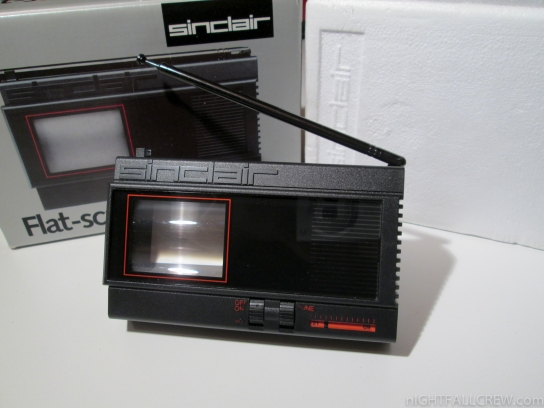Sinclair FTV1/B Boxed Mint Condition

Autopsy:
You can use any power supply with 6v / 1.5 amp with the polarity described below:

Polarity is positive + on the outside or barrel and negative - on the inside or tip
from Wikipedia and The National Valve Museum homepage:
The Sinclair TV80, also known as the Flat Screen Pocket TV or FTV1, was a pocket television launched by Sinclair Research in 1984. Unlike Sinclair’s earlier attempts at a portable television, the TV80 used a flat CRT with a side-mounted electron gun instead of a conventional CRT; the picture was made to appear larger than it was by the use of a Fresnel lens.
The set has a 2 in. screen, measures 5= x 3= x 1< in. and weighs 9= oz. A special Polaroid flat battery that provides 15 hours’ operation has been produced to power it — there’s also a mains adaptor. The set itself goes on sale at #79.95, with the 6V Polaroid lithium batteries in packs of three at #9.95 per pack and the adaptor at #7.95, all prices inclusive of VAT, postage and packing. Normal retail and export sales are expected to start during the first half of 1984. Sir Clive Sinclair predicts sales rising to a million or more a year worldwide, and speaks of the set ‘achieving for television what the transistor radio did for wireless, creating a new one-per-person product’.
The set has some interesting technical features. It is for example a multi-standard receiver with automatic switching between most UHF standards worldwide except for France. Most of the circuitry is contained within a single ic that uses innovative digital techniques to monitor the vision and sound signals and adjust the circuitry automatically to suit the transmission standard. The ic was jointly developed by Ferranti and Sinclair Research and is being produced by Ferranti. Manufacture of the flat-screen tube (the gun is mounted to one side and the phosphor is deposited on the rear section of the viewing part) has been subcontracted to Timex in Dundee, using Sinclair designed and owned automatic plant. Assembly of the sets has been subcontracted to Thorn.
Apart from the tube and the ic, the main electronic items consist of the video output transistor, line and field output stages, the tube power supply generator and the tuner. The latter measures just 31 x 23 x 11 mm and uses hybrid microminiature components with advanced surface mounting. It’s output is at 230 MHz, which has been chosen to avoid image frequency problems in the UHF band.
It was a commercial failure, and did not recoup the £4m it cost to develop; only 15,000 units were sold. New Scientist warned that the technology used by the device would be short-lived, in view of the liquid crystal display technology being developed by Casio.
Download: Service Manual Sinclair FTV1 & FTV2 (2318)
Video:
source: wikipedia r-type.org







Advise if you have ftv-1 Sinclair flat panel for sale
Ciao, anche se sono passati tre anni dal post ci provo.
L’apparecchio che presenti e’ in vendita?